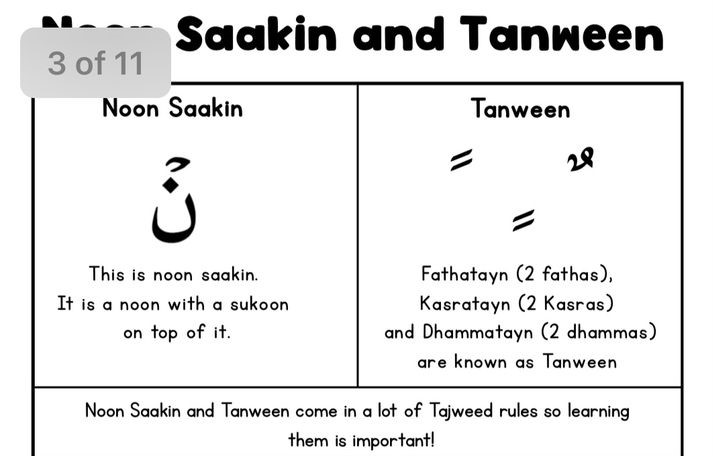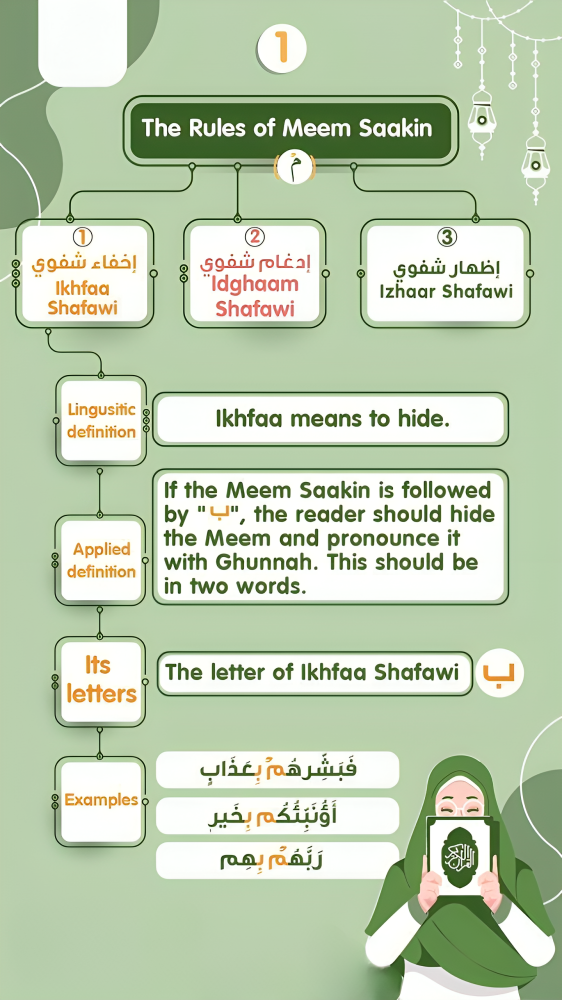Introduction
The rules governing Noon Sakin (نْ) and Tanween (ــً ــٍ ــٌ) are fundamental aspects of Tajweed that ensure proper Quranic recitation. These rules are essential for maintaining the authenticity and beauty of the Quran’s pronunciation while preserving its intended meanings.
Understanding the Basics
What is Noon Sakin?
Noon Sakin (النون الساكنة) is a noon letter with a sukoon (نْ) indicating no vowel sound. It appears:
- In the middle of words
- At the end of words
- In both nouns and verbs
- As a permanent part of the word’s structure
What is Tanween?
Tanween (التنوين) refers to the double dammah (ــٌ), double fathah (ــً), or double kasrah (ــٍ) at the end of nouns, creating a noon sakin sound when pronounced. Key characteristics:
- Only appears at the end of nouns
- Pronounced as a noon sakin but not written as one
- Not permanent in the word’s structure
- Disappears in continuous reading when joining words
The Four Rules
1. Izhar (Clear Pronunciation – الإظهار)
Definition: Pronouncing the noon sakin or tanween clearly without merging or hiding.
Letters: occurs with six throat letters (الحروف الحلقية):
- ء (Hamzah)
- ﻫ (Ha)
- ع (‘Ayn)
- ح (Ha)
- غ (Ghayn)
- خ (Kha)
Examples:
- مَنْ ءَامَنَ (Man Aamana)
- مِنْ خَيْرٍ (Min Khayr)
- عَلِيمٌ حَكِيمٌ (‘Aleemun Hakeem)
2. Idgham (Merging – الإدغام)
Definition: Merging the noon sakin or tanween into specific letters that follow.
Types:
- Idgham with Ghunnah (With nasalization):
- ي (Ya)
- ن (Noon)
- م (Meem)
- و (Waw)
- Idgham without Ghunnah (Without nasalization):
- ل (Lam)
- ر (Ra)
Examples:
- مِنْ يَعْمَلْ (Min Ya’mal) → Merges with nasalization
- مِنْ رَّبِّهِمْ (Min Rabbihim) → Merges without nasalization
3. Iqlab (Converting – الإقلاب)
Definition: Converting noon sakin or tanween into a hidden meem when followed by ب (Ba).
Example:
- مِنْ بَعْدِ (Min Ba’di) → Pronounced as “mim ba’di”
- سَمِيعٌ بَصِيرٌ (Samee’un Baseer) → Pronounced with a hidden meem
4. Ikhfa (Hiding – الإخفاء)
Definition: Partially hiding the noon sakin or tanween when followed by any of the remaining 15 letters.
Letters: The remaining letters not covered by other rules:
- ت، ث، ج، د، ذ، ز، س، ش، ص، ض، ط، ظ، ف، ق، ك
Examples:
- مِنْ تَحْتِهَا (Min Tahtiha)
- عَذَابٌ شَدِيدٌ (‘Athabun Shadeed)
Practical Tips for Application
1. Duration Guidelines
- Ghunnah (nasalization) should be held for:
- 2 counts in Idgham with Ghunnah
- 2 counts in Ikhfa
- 2 counts in Iqlab
2. Common Mistakes to Avoid
- Over-nasalization
- Extending Ghunnah beyond 2 counts
- Adding Ghunnah where not required
- Incomplete Merging
- Partial implementation of Idgham
- Not fully completing the merging process
- Incorrect Ikhfa
- Making it too clear (like Izhar)
- Making it completely hidden (like Idgham)
3. Practice Methods
- Systematic Approach
- Learn one rule at a time
- Master each rule before moving to the next
- Practice with common examples first
- Recording and Review
- Record your recitation
- Compare with expert reciters
- Note areas for improvement
- Regular Exercise
- Daily practice with specific verses
- Focus on problematic combinations
- Seek feedback from qualified teachers
Benefits of Proper Application
- Spiritual Benefits
- Enhanced connection with the Quran
- Better understanding of the text
- More rewarding recitation
- Technical Benefits
- Improved pronunciation
- Better flow in recitation
- Enhanced memorization
- Educational Benefits
- Deeper understanding of Arabic phonetics
- Better appreciation of Quranic sciences
- Stronger foundation for advanced studies
Tools for Learning
- Educational Resources
- Color-coded Qurans
- Tajweed apps
- Online tutorials
- Practice worksheets
- Technology Aids
- Digital Quran apps with Tajweed rules
- Online recitation analysis tools
- Interactive learning platforms
Conclusion
Mastering Noon Sakin and Tanween rules is crucial for proper Quranic recitation. While the rules may seem complex initially, systematic practice and proper guidance can lead to proficiency. Remember that these rules were established to preserve the authentic pronunciation of the Quran and ensure its proper transmission across generations.
About the Author
This comprehensive guide is published on Baytul Quran, your trusted source for Quranic learning and Tajweed education.





